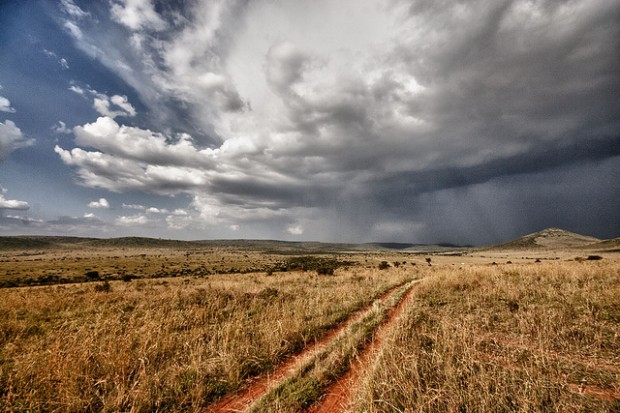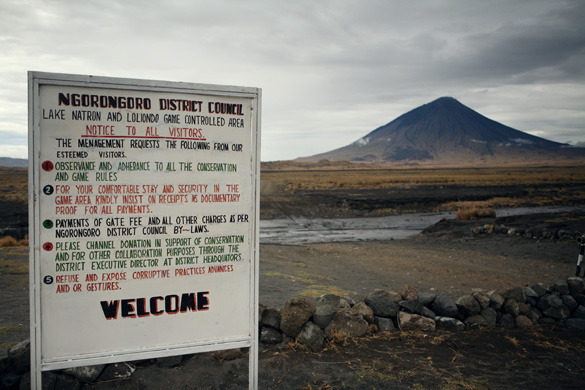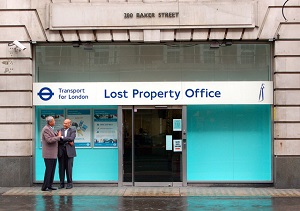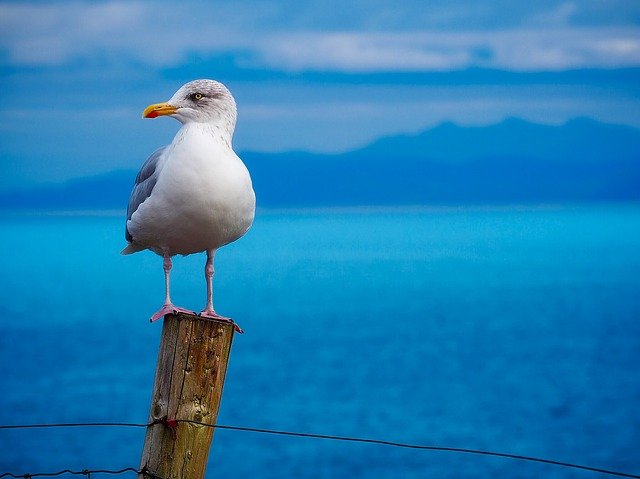You have no items in your cart. Want to get some nice things?
Go shopping
Menengai, Alex our guide tells us, means “the place where God is not”. It is a word from the Masai, the great African tribe that traverse the land with their cattle, naming the places as they find them. Looking down into the vast green caldera, all that remains of the immense volcano, I can imagine the handsomely dressed Masai, their scarlet cloaks vivid in the foliage, and their great herds. A desultory drift of smoke catches Nick’s eye.
[private]“Is that from the volcano? Is it still alive?” He is almost excited. Alex tells him local people often go there to make charcoal.
No one lives in the caldera; it is too hot, too difficult to reach. There are no animals either. A few houses perch near the western rim, but mainly people live in the scatterings of buildings in the wide flat valley. On the way up the steep dirt road, we had passed through a village – painted signs declaring a primary school, a shop, and a hotel – at the point that Alex said was half-way. We had passed donkeys, strung around with empty 50 gallon plastic drums, walking in patience towards us. And women drudging, backs bent under sacking stuffed with charcoal or firewood, held to their bodies by straps around their foreheads.
At one point, the long dusty road had almost defeated Alex’s car. The radiator fizzed and boiled, and we sat in silence, listening to it, blocking the rutted track of fine golden earth. When it was calm again, he restarted the engine, and our sweat cooled on our skin in the revived breeze. At the top, Alex drew the car up in the shade of an empty kiosk. There were only a few stall holders, stone carvings and necklaces on display. Few tourists take the time to come to the lowering green ridge. There isn’t much to see, apart from the view itself.
Teenage school children mill in small groups around the edge of the crater. I take out my camera, still new, still expensive, wary of both the dust and the curiosity. Four girls appear in shot, as I line up the digital screen with the plain of Nakuru and Lake Elementeita beyond. Grouping together, they eye the brushed steel with envious curiosity in their open faces. Their uniforms are fresh, clean, and show no signs of wear, and their shoes fit their feet. These are children from well-off Kenyan families, and suddenly I don’t feel so bad about my own privileges.
The three of us slip and skid further along the rim, down a slope to a promontory. Underfoot are tiny pieces of pumice, light and aerated, in shades from yellow to grey.
Nick falls over, almost pulling me down with him. Sparkly flip-flops were not the best choice of footwear today, and I take Nick’s arm, my camera in my other hand.
I had read somewhere that the Masai threw their dead into the crater, and the smoke is their spirits, rising to heaven. That was along time ago, Alex says. We are too shy, too polite, to ask if his own great height comes from Masai blood.
We pose for photos by a tall pole, painted black and white, with the Rotary Club wheel atop the crater’s vital statistics. It is 2,490 metres high, 12 kilometres across and 500 metres deep. Wooden arms cartwheel out, measuring monochrome distance to Rome, London, Mount Kenya, Cape Town and New York. As none of us live in any of these places, we mentally added our own. Edinburgh. Nyahururu.
“But isn’t Mount Kenya to the north east of here?” We have been there. The sign seems to point west.
“Yes. That way,” and Alex sticks out his arm, pointing the same way as the sign. My world flips and north becomes south, east becomes west, and the sun hangs upside down. I marvel again at how my internal compass is so unreliable south of the Equator.
The school children are moving off now, their black shoes and white socks grey from the cloud of dust which follows them at ankle level.
“Where is their bus?” Nick is concerned about them walking in the heat.
“We passed it on the way up,” Alex replies, “It was pulled over in the shade. Not far.”
The heat from the ground, from the air, is intense. We had left the town late as usual and I guess it is at least 11.30, maybe even heading closer to noon. Alex suggests that we walk along to the watch tower, and onto a high promontory, where the cliff face burns ochre, curving like the haunch of a lion.
The watch tower looks rickety, gaps in the platform floor visible from below.
We walk along the narrow rabbit tracks between the tufts of coarse grass, not making eye contact with the dirty tattered children standing in the shadow of the tower. We collectively tense in preparation for the usual mantra.
“Mzungu! You give me money! You give me sweet!”
But Alex speaks to them. He is Kenyan, after all, his very presence will prevent us from being harassed. And he would never pass a child by. His humanity overwhelms us, but we keep walking, eyes scanning for a good view to photograph, grateful that Alex is keeping the begging children at bay.
He re-joins us, looking concerned. “They are telling me that a child has fallen into the crater.”
A child? Who? When did it happen? Where is he?
He doesn’t know, but lopes over the ridges and rises of the hillside towards a group of adults who are standing at the edge of the cliff. We follow him, not really understanding what is going on. The group of adults are all men, and they have dogs and carry long staffs. We do not see their goats until later.
“I don’t like this,” Nick mutters, his face screwed up behind his hat and dark glasses, frowning against the sun. We draw to a ragged halt. Alex strides on. To us, the group looks menacing. They’ve seen our clothes, our sunglasses, our cameras. I feel vulnerable. It’s a trap, the small boys setting the trap for the compassionate foreigners. Is there really a child on the cliff?
The figures seem poised, as if in a tableau, embraced in the panorama of the greens and browns of the crater walls falling behind them. Alex is talking to them, vivid in his movements and actions beside their stillness.
Alex comes back, his stride swift and purposeful. “There is a child down there. They say he was sitting on the edge, looking over, and he lost his balance and fell.”
“Can you see him?”
“Who is he? Do they know him?”
“How old is he? Is he injured?”
Alex shakes his head, “No one can see him, and they can’t hear him. They think he is hanging on the rocks somewhere. They don’t know if he is injured.”
“When did it happen, Alex?”
We are poised for the answer, but we know it already.
“Just now. Not long ago. While we were here.”
While we were here. Present at the tragedy. While it happened. We become responsible – we feel it: but responsible for what? Whatever it is, we are responsible for something.
“How old is he, Alex?” We have to make his image even more real.
“About his age,” Alex indicates a small dust covered child dressed in a faded T-shirt and shorts of indeterminate colour. He is walking parallel to us, along the edge of the caldera, a stick in his hand. He looks about 5 years old, out alone, walking with purpose.
“Are his parents there?”
“No. He was alone. The other children know him, but he doesn’t belong to these people. He was just there, beside them.”
I don’t want to ask his name, but I don’t think that Alex will have asked anyway.

A plan is forming in my head, but how to get down into the caldera? Once there, how to get across to the cliff? Are we expected to do something? Or only to observe?
Alex is walking past us, away from the cliff, away from the child. We follow him silently, our cameras tucked away. We are embarrassed by them now. We have photographed the sweeping panorama of the cliff – what have we really witnessed? What images are hidden within the pixels? Somewhere, somewhere on these rocks, a tiny child is lying crumpled and broken, fear and pain surrounding him. He is crying, trembling, and tourists are unknowingly photographing him.
We follow Alex in silence, back the way we have come. The car is in sight, but I can’t believe that we are just going to leave. However, we stop by a group of men, sitting on a boulder, their binoculars looking back to where the small figures peer over the edge of the cliff. Alex is asking them if they can see the child. No, they can’t. They were told that he had fallen, and they are trying to locate him, but he isn’t visible from this vantage point. He must be round the far, unseen side of the cliff. People are still sitting and standing, they are looking over, but there seems to be no flurry of activity.
“Has someone called the police?”
Alex shrugs, “No one will call them because they will not come.”
What’s to be done then? Who will come? What next?
The three men with the binoculars have walked off towards the rim of the caldera. A woman tells me that last year a teenage girl fell over the edge and died. There are no barriers, no warning signs, no rangers or guards. It makes for a beautiful, uncluttered photograph. I shake my head in disbelief and say words like ‘unbelievable’ and ‘shocking’. Terrible. But these words have lost their meanings somehow.
Alex has his phone clamped to his ear, and I realise that he will know what to do; he will do something, and it will be all right. Alex shakes his head. “I am calling the police but no one is answering.” I know that he will keep trying. And I know that he is only trying for us.
What can we do? The sun is high overhead, draining, desiccating. Nick offers me his hat, but I refuse. How can I complain about the burning heat now? We sit down, one by one, on the spiky grass and knobbly pumice. The hot air weaves around us like a cloak. Like a Masai cloak.
We see the three men who have the binoculars, and they are somewhere between us and the far cliff, edging sideways down a more forgiving slope towards the valley. But it is still steep, rugged, and at any time any one of them could lose his footing and tumble, limbs flailing, onto the crater floor. That would be a visible tragedy to us, not like the ghostly boy hidden somewhere by the turning of the cliffs.
Alex confirms that they are going to look for the child. They are brave. He also says that he has spoken to the police now, and that they have said that they will come. We are waiting for them.
The men shrink to become the colour of their shirts, small bright shapes in the shadow of the crater. One breaks into a scrabbling run, and my heart flips, but he leaps onto a boulder, pivots and steadies himself, then moves on out of sight. They all vanish, and we sit waiting in silence.
The sun is burning my scalp where the hair folds away from the parting. I can feel my shoulders and my arms prickling. I am thirsty; I have the beginning of a headache behind my eyes. I have left my hat and water bottle in the car. We weren’t going to be long: there wasn’t much to see. It would feel somehow frivolous, disrespectful, if I asked Alex for the car keys to fetch them now. I must endure.
There is a group of pale middle-aged tourists over by the black and white pole now, posing for photos, as we had done earlier. They don’t walk to the watch tower. They don’t ask us how we are, or why we are sitting in the sun. It is as if only they exist to themselves. We are all invisible – the cliff, the boy, the men in the crater, the watchers from above.
I try to imagine the child again. He is lying on his back perhaps, frightened, winded, but alive. I submit to the heat of the equatorial sun, and the dusty thirst as if, in some way, I can at least take thispart of his suffering from him.
But I realise what I really want to do is to go. To leave. There’s nothing we can do anyway, except watch the rest of the tragedy unfold. Three men are now in the crater searching for him. Their height and strength make them more likely rescuers than I could be. It is the truth, but still I feel that it is an excuse.
In a swirl of dust, another school coach rattles into view. Eager faces lean out of the windows, but we do not acknowledge their smiles and greetings. We do not wave back, but watch them come to stand dangerously close to the edge, and wonder where their teachers are. Their white shirts look unnatural in these surroundings, and the girls have elaborate hairstyles. One of them has evidently asked what everyone is watching for, and she gasps and puts her had to her mouth, then tells her friends with wide-eyed excitement. They gasp, exclaim and stare at the cliff. The story ripples through the clustered groups, and then they are gone, back onto the bus.
The men appear to us on the crater floor, then disappear again around the curvature of the cliff. I feel that I should pray, but it doesn’t seem real.
Finally, I have to ask Alex for the car keys to retrieve my hat and water. This short burst of activity restores our energy, and we stand again, and start wondering where the police are, and whether the boy’s parents have been told. Alex tells us that several months previously, a tourist fell into the crater. Rescuers reached him within hours and tended to him where he was found. A helicopter lifted him out the following day. But no one will call the helicopter for this child. They do not even know if he is alive.
He has to be. We cannot be witness to a child’s death. This was not our purpose when we set out this morning.
Alex’s phone rings, the maddening chirrup that we usually tease him about. His words are short and clipped. He shakes his head, and – thrilled – we fear the worst. “The men in the crater cannot see him. He is hanging somewhere above on the cliffs, but they cannot reach him.”
No one can reach him without ropes. Who has ropes? The rangers at Mount Kenya, four hours away. No one has ropes here.
Alex tells us we should leave, and our relief is palpable, even as we despise ourselves for it.
We drive onwards, downwards, pluming dust behind us. Just below the turn and the dip from the top, I see a house that I had not noticed on the way up, built from stone, blending into the scenery. Approaching us from below, a ragged crowd of people are trying to run up the steep road. The man in the lead is stout, but propelling himself onward with a long stick. We stop, and his sweat-beaded face fills the open window. Others cluster behind him. They have been told about the child, a child from their village, and Alex tells them what he knows. People are still running, and a woman in a scarlet skirt is wiping her eyes as she hurries up the impossible slope in the heat. The community’s anguish and pain is visceral. They disappear behind us in our dust. We do not pass anyone else.
Alex has no answers for us, but asks if we will go with him to the police station. He tells us that if he takes us, two white people, the police will be more likely to act. We don’t want to believe him, but go with him willingly, with a feeling of purpose. We are doing something.
The police station is dark inside, despite its sky-blue walls. A crush of people is blocking the access to the desk, protected by floor to ceiling iron bars. A ripped sign on the wall tells us
It is your right to speak to someone here.
You are not expected to give a bribe.
Our presence attracts attention, and Alex uses this to press his case. We are ushered into a small room with many chairs. A man, who is not in uniform, shakes our hands. Alex explains the situation, and the man replies. We do not know the words they use, but can guess their meaning. All too quickly we are back out into the sunlight under the purple jacaranda trees. “He says that they will go,” Alex tells us.
There is nothing to say, nothing more to be done, and we each try to follow our way through the rest of the day. But every time we speak, all we can feel is a crunching between our teeth, the dust from the godless place.[/private]

About Ailsa Thom
Ailsa has travelled extensively in South America and Africa. Now living back in Scotland, she spends the free time between working and writing trying to tame the garden, and firmly believes that going salsa dancing is equivalent to a trip to the gym. Ailsa has had work published in Litro, McStorytellers, Myslexia, Flash Fiction Magazine and The Ghost Story. She writes the travel blog enroutetonowhere.wordpress.com




